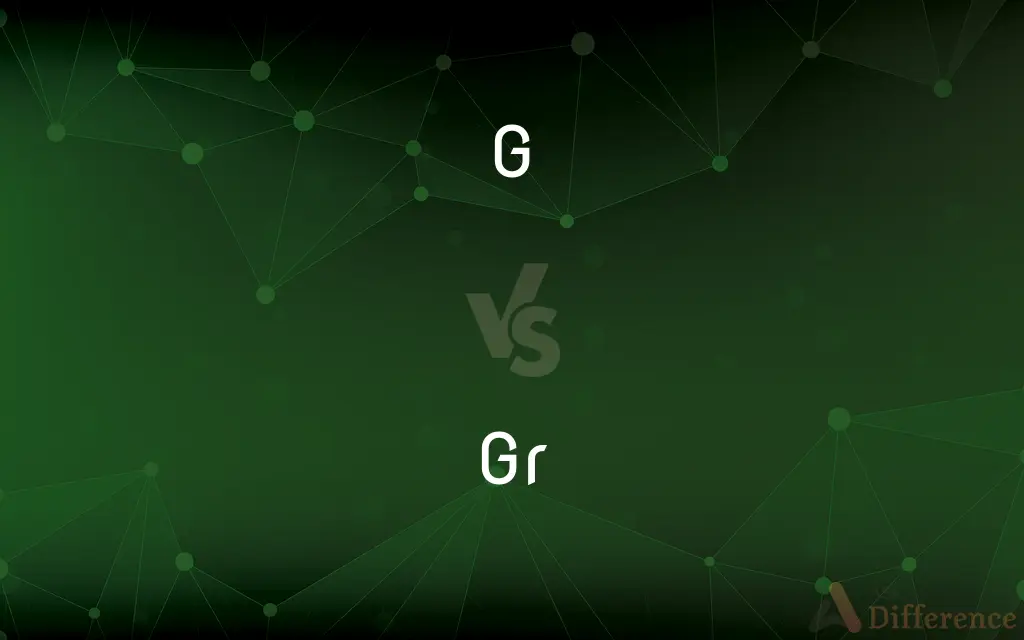G vs. Gr — What's the Difference?
By Urooj Arif & Fiza Rafique — Updated on March 29, 2024
G represents the gravitational constant, while Gr, often abbreviated for grains, is a unit of mass in the avoirdupois system, highlighting their distinct scientific roles.

Difference Between G and Gr
Table of Contents
ADVERTISEMENT
Key Differences
G, or the gravitational constant, is a fundamental constant in physics that quantifies the strength of the gravitational force between two objects. Its value is crucial for calculations in the field of gravitational physics and astrophysics, helping to explain the motion of planets, stars, and galaxies. On the other hand, Gr, short for grains, is a unit of mass originating from the historical use of grains of wheat or barley as a standard of measurement. In modern terms, it is used primarily in the fields of pharmacy and jewelry to measure small quantities of materials.
The gravitational constant (G) has a pivotal role in Newton's law of universal gravitation, which describes the gravitational attraction between objects with mass. The concept of G allows scientists to calculate the gravitational forces in the universe, impacting our understanding of phenomena such as planetary orbits and black holes. Grains (Gr), while less fundamental to the fabric of the universe, serve a practical role in precise measurements, especially in applications requiring fine scales, like the dispensing of medication or the valuation of precious metals and gemstones.
Despite their vastly different applications, both G and Gr highlight the diverse scales and contexts in which measurement and constants are vital. From the cosmic scale of gravitational interactions to the minute details of pharmaceutical dosages, both play integral roles in their respective domains.
G is expressed in units(newton meters squared per kilogram squared), reflecting its nature as a measure of force per mass per distance squared. Conversely, grains are a part of the avoirdupois system, with one grain equivalent to approximately 0.0648 grams, showcasing its application in measuring mass directly.
Comparison Chart
Definition
A fundamental constant quantifying gravitational force.
A unit of mass in the avoirdupois system.
ADVERTISEMENT
Application
Gravitational physics, astrophysics.
Pharmacy, jewelry, ballistics.
Significance
Essential for calculations of gravitational forces and understanding the universe's structure.
Used for precise measurements of small quantities.
Example Usage
Calculating the force of attraction between Earth and the Moon.
Measuring the mass of active ingredients in medications.
Compare with Definitions
G
The constant of proportionality in Newton's law of universal gravitation.
G determines the strength of the gravitational pull between two masses.
Gr
Used in pharmacy to measure drug quantities.
The prescription required 15 grains of the medication.
G
Fundamental in theories of gravity and cosmology.
G is crucial for understanding the dynamics of the universe.
Gr
A unit of mass equal to 1/7000th of a pound.
The jeweler weighed the gold using grains for precision.
G
A universal physical constant.
The gravitational constant G applies uniformly across the cosmos.
Gr
Still used in jewelry to quantify gem weights.
The diamond was 5 grains, a measure of its small mass.
G
Essential for calculating gravitational forces.
Scientists use G to estimate the mass of celestial bodies.
Gr
Historically based on the mass of a single grain of wheat.
Grains were once a universal standard for small measurements.
G
G, or g, is the seventh letter of the ISO basic Latin alphabet. Its name in English is gee (pronounced ), plural gees.
Gr
Applicable in ballistics for measuring bullet weights.
The bullet's weight was listed as 150 grains.
G
The seventh letter of the alphabet.
Gr
Abbreviation of graina unit of mass.
G
The fifth note in the diatonic scale of C major.
Gr
(rare) gram the standard symbol for gram since the International System of Units was introduced in 1960 is g.
G
The seventh letter of the modern English alphabet.
G
Any of the speech sounds represented by the letter g.
G
The seventh in a series.
G
Something shaped like the letter G.
G
The fifth tone in the scale of C major or the seventh tone in the relative minor scale.
G
A key or scale in which G is the tonic.
G
A written or printed note representing this tone.
G
A string, key, or pipe tuned to the pitch of this tone.
G
One thousand dollars
Lost twenty Gs at the racetrack.
G
(physics) A unit of gravitational acceleration.
G
Abbreviation of gram
G
Abbreviation of grand
G
(Internet slang) grin
G
G is the seventh letter of the English alphabet, and a vocal consonant. It has two sounds; one simple, as in gave, go, gull; the other compound (like that of j), as in gem, gin, dingy. See Guide to Pronunciation, 231-6, 155, 176, 178, 179, 196, 211, 246.
G
G is the name of the fifth tone of the natural or model scale; - called also sol by the Italians and French. It was also originally used as the treble clef, and has gradually changed into the character represented in the margin. See Clef. G$ (G sharp) is a tone intermediate between G and A.
G
A metric unit of weight equal to one thousandth of a kilogram
G
A purine base found in DNA and RNA; pairs with cytosine
G
One of the four nucleotides used in building DNA; all four nucleotides have a common phosphate group and a sugar (ribose)
G
The cardinal number that is the product of 10 and 100
G
A unit of force equal to the force exerted by gravity; used to indicate the force to which a body is subjected when it is accelerated
G
A unit of information equal to one billion (1,073,741,824) bytes or 1024 megabytes
G
(physics) the universal constant relating force to mass and distance in Newton's law of gravitation
G
The 7th letter of the Roman alphabet
Common Curiosities
What is the significance of grains in measurement?
Grains provide a precise unit of mass, important in fields like pharmacy and jewelry, where accuracy in small quantities is critical.
Can grains be converted to other units of mass?
Yes, grains can be converted to other units of mass, such as grams, with 1 grain being approximately equal to 0.0648 grams.
What makes G a universal constant?
G is considered a universal constant because its value is the same throughout the universe, governing the gravitational force between any two masses.
How was the value of G determined?
The value of G was first determined through experiments that measured the force of attraction between masses, such as the Cavendish experiment.
How does G affect our daily lives?
Although not apparent in daily activities, G affects our lives by determining the gravitational pull of the Earth, which influences everything from our weight to the behavior of the ocean tides.
Are grains still used in modern measurements?
While not as common as metric units, grains are still used in specific applications like pharmacy, jewelry, and ballistics for their historical and practical value in measuring small quantities.
What challenges exist in measuring G accurately?
Measuring G accurately is challenging due to the weak nature of the gravitational force compared to other fundamental forces, requiring sensitive equipment and conditions to minimize experimental errors.
Why is the gravitational constant important in physics?
The gravitational constant is crucial because it allows physicists to calculate the gravitational forces between objects, essential for understanding celestial mechanics and the structure of the universe.
How has the use of grains evolved over time?
The use of grains has evolved from a general unit of measurement in ancient times to a specialized unit in modern applications like pharmacy and jewelry, reflecting changes in measurement standards and practices.
Why are grains a preferred unit in certain fields?
Grains are preferred for their precision in measuring small quantities, which is essential in fields requiring accurate dosages or valuations, such as medications or precious materials.
Share Your Discovery

Previous Comparison
Antheridium vs. Antheridiophore
Next Comparison
Gestalt vs. SynergyAuthor Spotlight
Written by
Urooj ArifUrooj is a skilled content writer at Ask Difference, known for her exceptional ability to simplify complex topics into engaging and informative content. With a passion for research and a flair for clear, concise writing, she consistently delivers articles that resonate with our diverse audience.
Co-written by
Fiza RafiqueFiza Rafique is a skilled content writer at AskDifference.com, where she meticulously refines and enhances written pieces. Drawing from her vast editorial expertise, Fiza ensures clarity, accuracy, and precision in every article. Passionate about language, she continually seeks to elevate the quality of content for readers worldwide.















































